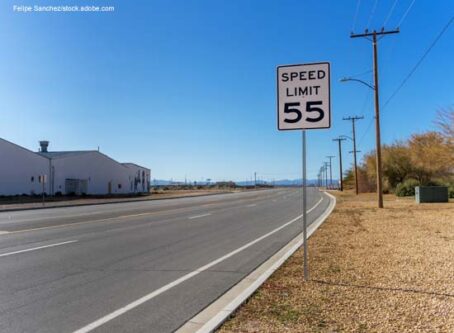States approve, pursue expanded ‘move over’ rules
Pursuits at statehouses from Virginia to North Dakota call for expanding move-over rules to apply to all highway users.
There are nine states that include all road users in their move-over law, AAA reports. Maryland adopted the rule one year ago, joining Arizona, Connecticut, Illinois, Iowa, Oklahoma, Oregon, Pennsylvania, and Tennessee.
A growing trend in state legislatures is to do the same. Below is a roundup of recent statehouse activity on the issue.
Colorado
A new law in Colorado expands the state’s move-over rule.
State law already requires drivers to move over one lane or, if moving over is not possible, reduce and maintain a speed 20 mph below the posted speed when approaching or passing a stationary authorized emergency vehicle, tow truck, public utility service vehicle, or a vehicle being equipped with tire chains.
The legislature acted this year to send a bill to the governor to add to the list of stationary vehicles giving a hazard signal.
Failure to make room or slow down for affected vehicles could result in a careless driving offense. Violators would face punishment that starts at a minimum $150 fine or at least 10 days in jail.
According to a fiscal note, over the most recent three-year period, 230 people were sentenced for “failing to exhibit due care and caution” when approaching or passing certain vehicles.
“Motorists who fail to comply with this law, paired with common driving distractions, create a dangerous and sometimes deadly combination on Colorado’s roadways,” reads the Colorado State Patrol website.
Gov. Jared Polis has signed HB1123 into law. It takes effect in August.
Virginia
The state of Virginia could soon have its own move over rule revision.
Virginia law mandates that travelers on roadways with at least two lanes in one direction proceed with caution and, if reasonable, yield the right-of-way to emergency vehicles by making a lane change into a lane not adjacent to the stationary vehicle. If a lane change is unreasonable or unsafe, drivers must “proceed with due caution and maintain a safe speed for highway conditions.”
One piece of legislation sent to Gov. Glenn Youngkin’s desk would expand the protection to include any highway user along the roadside displaying hazard lights, caution signs, road flares or torches.
Senate Transportation Committee Chairman Sen. David Marsden, D-Burke, said the goal of SB982/HB1932 is safety for all highway users.
“If a driver pulls over to rest or for whatever reason, that is going to improve their ability to operate an automobile, I think we ought to give them the courtesy of keeping them safe by having people slow down and move over,” Marsden previously testified.
Truckers welcome change
Marty Ellis, driver of the OOIDA tour truck, says most truck drivers believe in move-over rules. He points out that if a trucker is unable to change lanes, state laws across the country are vague when it comes to how much drivers are expected to slow down.
“It needs to be uniform so everybody knows and understands it,” Ellis said.
He adds that roadway users make worse the safety concern when they stop along roadsides to swap drivers, let dogs out or to take a break.
“Anyone that has ever been broken down on the shoulder sees all the vehicles that don’t get over and how dangerous it can be.”
Montana
In Montana, a bill forwarded to Gov. Greg Gianforte would revise the state’s move-over rule to include more vehicles in the protection.
Currently, statute applies the protection to emergency vehicles, police vehicles or tow trucks displaying flashing or rotating amber, blue, red, or green lights or any temporary sign. Road users are required to reduce speed or move to a lane away from the stopped vehicle before passing.
HB320 would add highway maintenance vehicles and utility vehicles to the rule while displaying flashing or rotating amber, blue, red, or green lights or any temporary sign.
A committee change made to the bill removed inclusion of “other vehicles,” which would have included cars and trucks.
New York
One New York Assembly bill would expand the state’s move-over law to include vehicles parked on the shoulder of a highway.
State law already includes the protection emergency vehicles, hazard vehicles, and vehicles displaying a blue or green light.
Sponsored by Assemblyman Kenneth Zebrowski, D-Rockland, AB1077 would require vehicle operators to “exercise due care” to avoid colliding with a vehicle parked, stopped or standing on the shoulder or any portion of a highway.
Zebrowski wrote in a bill memo that while existing law has been effective in protecting law enforcement and emergency vehicles that are stopped on the side of roadways, “there are still tragedies each year involving other motorists that are killed or seriously injured while stopped on the shoulder.”
The bill would require vehicle operators to safely move over for any vehicle on the shoulder, if possible.
A1077 is in the Assembly Transportation Committee.
North Dakota
North Dakota law requires drivers to move over to an adjacent lane or slow down to a “safe” speed before passing emergency vehicles or transportation department vehicles with flashing lights activated. Exceptions are made for situations when safety, road, weather and/or traffic conditions do not allow.
The Senate Transportation Committee recently discussed the bill that is intended to help protect the lives of all drivers on the state’s fastest roadways. House lawmakers already approved the bill by an 88-5 vote.
Rep. Austen Schauer, R-West Fargo, told committee members many drivers in the state are unclear which types of vehicles are included in the protection.
“What it clearly does not cover is a school bus, a motor coach, a tractor-trailer, or a family vehicle,” Schauer said.
He added that most drivers do slow down or move over for any vehicle sitting on the side of the highway with hazard lights flashing, but some do not.
His bill, HB1141, would require drivers approaching a vehicle displaying flashing hazard warning signals on a highway outside the limits of a city to move over a lane or slow down while maintaining a “safe speed for the road conditions.”
Violators could face $20 fines.
AAA welcomes pursuit for inclusion of all vehicles in move-over rules.
“The underlining purpose of HB1141 is to put an unwritten rule into writing,” testified Gene LaDoucer of AAA. “Doing so makes the law clearer; education efforts become easier; enforcement is straightforward; and the safety of all road users is improved.”
Tennessee
A similar pursuit is underway at the Tennessee statehouse.
State law requires travelers to move over or reduce speed for first responder, highway maintenance and utility vehicles using emergency signals. Drivers who fail to move over or slow down for affected vehicles could face up to $500 fines.
Identical bills, HB92/SB201, would add to the protection any disabled vehicle with hazard lights activated. Additionally, first-time violators of the rule would face fines up to $250. Subsequent violations would result in escalating fine amounts up to $2,500.
The Tennessee Department of Safety reports since 2018 there have been an average of 1,585 convictions annually for the offenses covered under the bill.
Both bills have received committee consideration and await further action.
Efforts fail elsewhere
Attempts to adopt similar rule revisions failed to move forward in Georgia and Minnesota.
Georgia law mandates vehicle operators to move over or slow down for stationary authorized emergency vehicles, towing or recovery vehicles, highway maintenance vehicles, or utility service vehicles. The protection applies when the affected vehicles are displaying flashing lights or using traffic cones.
A House-approved bill called for including more vehicles in the protection rule. The Senate Transportation Committee, however, amended HB119 to remove any reference to the rule.
In Minnesota, statute requires drivers to move over or slow down for emergency vehicles stopped along the roadside. Ambulance, police car, tow truck and road maintenance vehicles are among the vehicles protected under the safety rule.
Identical bills introduced in the House and Senate called for applying the same protection to highway maintenance vehicles, utility service vehicles, or other vehicles.
Both bills, HF2031/SF1360, failed to advance from committee before deadlines. LL









